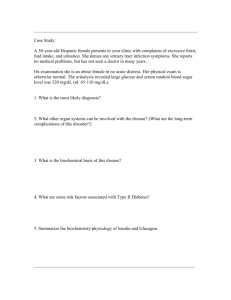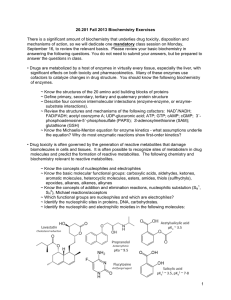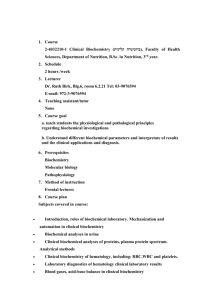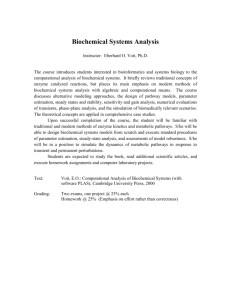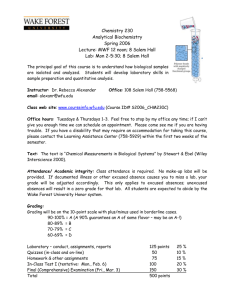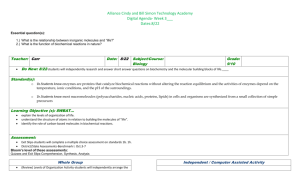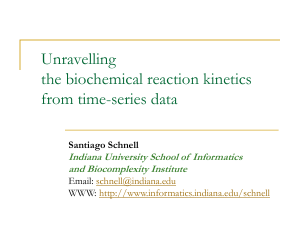Document 14519945
advertisement
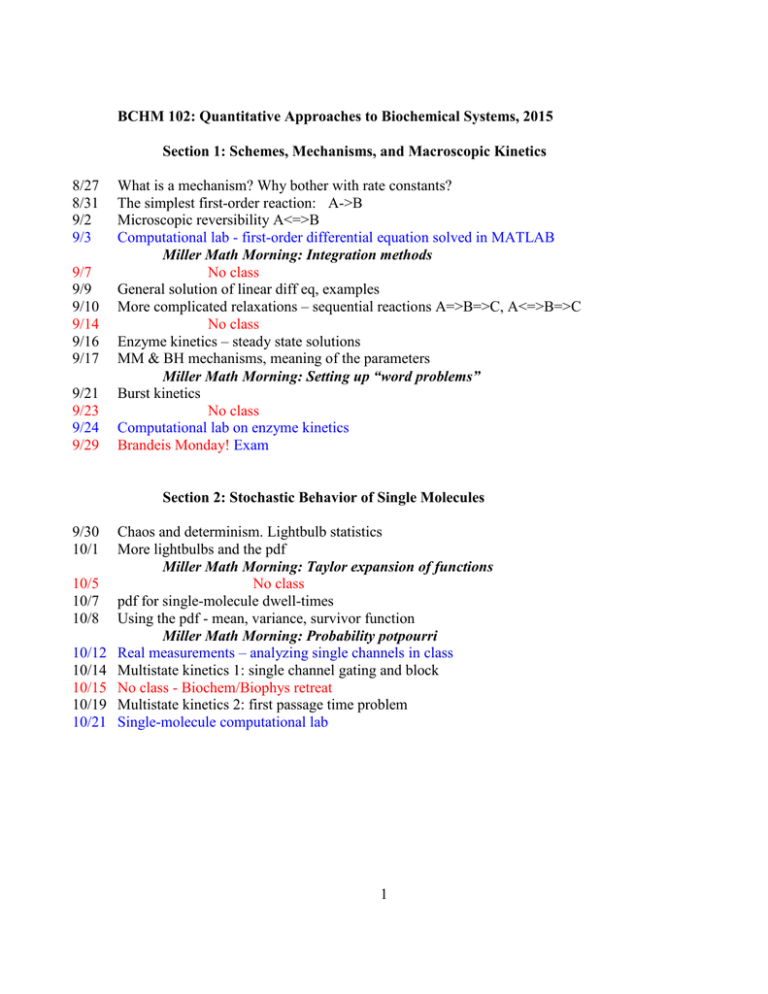
BCHM 102: Quantitative Approaches to Biochemical Systems, 2015 Section 1: Schemes, Mechanisms, and Macroscopic Kinetics 8/27 8/31 9/2 9/3 9/7 9/9 9/10 9/14 9/16 9/17 9/21 9/23 9/24 9/29 What is a mechanism? Why bother with rate constants? The simplest first-order reaction: A->B Microscopic reversibility A<=>B Computational lab - first-order differential equation solved in MATLAB Miller Math Morning: Integration methods No class General solution of linear diff eq, examples More complicated relaxations – sequential reactions A=>B=>C, A<=>B=>C No class Enzyme kinetics – steady state solutions MM & BH mechanisms, meaning of the parameters Miller Math Morning: Setting up “word problems” Burst kinetics No class Computational lab on enzyme kinetics Brandeis Monday! Exam Section 2: Stochastic Behavior of Single Molecules 9/30 10/1 10/5 10/7 10/8 10/12 10/14 10/15 10/19 10/21 Chaos and determinism. Lightbulb statistics More lightbulbs and the pdf Miller Math Morning: Taylor expansion of functions No class pdf for single-molecule dwell-times Using the pdf - mean, variance, survivor function Miller Math Morning: Probability potpourri Real measurements – analyzing single channels in class Multistate kinetics 1: single channel gating and block No class - Biochem/Biophys retreat Multistate kinetics 2: first passage time problem Single-molecule computational lab 1 Section 3: Diffusion and Molecular Transport Processes (6) 10/22 10/26 10/28 10/29 11/2 11/4 11/5 Macroscopic & microscopic diffusion: Fick’s law and Einstein’s PhD thesis Random walk treatment of diffusion How fast can a chemical reaction be? Smoluchowski limit to reaction rates Diffusion to capture Computational lab - random walk analysis Reduction of dimensionality, sliding on DNA, membrane protein association EXAM Section 4: Basic Principles of X-ray Diffraction (6) 11/9 Learn to love the cosine: adding waves 11/11 Ducks in a row: adding many waves 11/12 Scattering vector and crystal diffraction Miller Math Morning: Complex exponentials as representations of waves 11/16 Going backwards: Fourier synthesis and the phase problem 11/18 Computational lab - Fourier synthesis, amplitudes and phases 11/19 Solving the phase problem for proteins: isomorphous replacement Section 5: Optical Spectroscopy (5) 11/23 11/30 12/2 12/3 12/7 12/9 Molecules and radiation: Quantum mechanics from 30,000 feet Absorption spectroscopy Fluorescence, basic principles Fluorescence, applications of anisotropy and energy transfer Fluorescence, real-life examples Last Class Exercise 2 Course Information Instructor: Chris Miller (cmiller@brandeis.edu) – Volen 415 M, W, Th, 11-11:50 AM, Volen 106 What is the course about? Understanding biological phenomena often comes down to comprehending the structures of the molecules that participate in biochemical processes and the ways that these molecules work and interact. Biochemistry textbooks are packed to the brim with such information, but where does this knowledge come from in the first place? A great deal of our knowledge about biochemical processes comes from just two basic types of laboratory experiments. First, we explore the mechanisms of biochemical reactions by measuring the rates of various reaction steps. Second, we infer the structures and behavior of biological molecules from the ways that they interact with electromagnetic radiation. All such experiments involve making and interpreting quantitative chemical and physical measurements on biochemical systems. This is not a laboratory course, nor will it teach the details of how to use specific techniques. Instead, the course covers basic principles that underlie a range of quantitative biochemical experiments and phenomena. Many of these principles arise from physical chemistry (the study of large collections of molecules), and their applications to real systems are worked out via mathematics. The aim here is to equip students with some of the basic attitudes, approaches, and knowledge they will require to read, critically evaluate, and ultimately contribute to original research in macromolecular biochemistry and biophysics. Another purpose of this course is to gain experience with mathematical methods in common use in the quantitative treatment of biochemical problems – linear differential equations in kinetics, concepts of probability, statistics, stochastic processes, fourier series. Students have seen most of these before but usually have not had much practice actually using them. My object here is not to torture students but rather to empower them by teaching a few of these tools and demystifying them so that when they are encountered in the biochemical literature later on, they will be seen as useful friends rather than as obscure tormentors. Required Preparation The course requires knowledge of basic biochemistry at the level covered in a good introductory college biochemistry course (e.g., Bchm 100). I will assume that you already are familiar with fundamental chemistry concepts like Gibbs free energy and chemical equilibrium and that you have had at least some previous exposure to basic chemical kinetics. A calculus-based introductory physics course is an essential prerequisite. You should be very, very familiar with the properties of common mathematical functions such as polynomials, logarithms, exponentials, and trig functions. You must also to be able to solve algebraic equations, differentiate, and integrate with ease and also to apply univariate calculus to the solution of physical problems stated in words. 3 Readings The course uses sections from two texts: Kuriyan, J. et al. (2013). The Molecules of Life. New York, Garland Press A pretty good general textbook emphasizing physical-chemical principles underlying biochemical analysis. Paperback, worth owning. Berg, H. C. (1983). Random Walks in Biology. Princeton, N.J., Princeton University Press. (This is a cheap paperback and an absolute gem - really worth owning.) Some of you may already have these texts, but if you don’t, you will not need to buy them, as the relevant sections will be posted on LATTE. You should also have available an introductory biochemistry text in case you need to refresh your memory of some of the background material. For those of you who feel rusty on your introductory calculus, I recommend that you buy a sweet little paperback “Quick Calculus” by Kleppner and Ramsey. The book emphasizes methods rather than proofs, and it takes you through many practice problems. I have posted the entire book as a pdf on the LATTE site. Handouts In addition to chapters from textbooks, I will sometimes post handouts. These represent my own way of thinking about certain subjects that I feel have not been covered adequately in the standard treatments, or sometimes just a different way of looking at standard material. I hope that they will clarify the issues for you, not confuse them. Whenever a handout confuses rather than clarifies, just ignore it. Expectations In this 4-credit course with 3 hours of class-time per week, students should be devoting at least 9-10 hours of study time per week in preparation in readings, papers, mathematical muscle-building, preparation for exams, and general mastery of the material. 4 Course Organization Problem sets. Much of the material covered in the course cannot really be understood just by listening to me jabber on about it; you have to try it out for yourself. For that reason, the problem sets are the most important part of the course. Along with readings, I will assign problem sets throughout the course. These must be turned in at the end of class on the due date. I will grade and return them, but the grades are merely for your information; problem set grades have almost no effect on your grade for the course. I will not look at problem sets turned in after the due date. Do not hesitate to collaborate with other students on the problem sets if you feel that this will help your understanding of the material. Lectures. See the course schedule for dates of lectures. Class starts promptly at 11:00.00. I usually begin each lecture by summarizing the most important point to be discussed, so don’t be late. Math help sessions. I will conduct “Miller Math Morning” sessions for help with various mathematical techniques used in the course. These 45-minute sessions will be given in Volen 106 at 8 AM on certain Thursdays to be announced. Attendance at these sessions is entirely voluntary. Questions. I welcome your questions both in and out of the lectures. I want to help you understand this quantitative material. Do not hesitate to see me in my office or lab if you have questions about the course, lectures, problems, etc. I do not keep office hours but am always available to be dropped in on except when I am traveling. Exams. There will be three exams. If you miss an exam, you will receive a failing grade, and no makeup exams will be given. In exceptional circumstances in which a student is absent from an exam due to a documentable emergency beyond the student’s control, I will give an oral exam at the whiteboard in my office. Any student requiring special academic accommodations in the exams or lectures should make arrangements immediately upon starting the course; see the Brandeis University Bulletin for details. Computational labs. Several class sessions will be spent doing Matlab exercises on your laptops. I do not expect you to become expert Matlab programmers, but you will learn to write simple Matlab scripts, so as to introduce you to this excellent program of wide utility in any scientific endeavor. Grades. Final grades will be determined based on exam scores and your class participation, along with bribes, the phase of the moon, and my mood on grading day. Monkey-points. Whenever you catch me making a mistake in lecture - either a dumb error in algebra or a deep one in analysis - do not restrain yourself from shouting out “MONKEY!” and pointing out the mistake for all to see. You will get extra points in the final grading-mix for each time you make a monkey out of me in front of the class. 5
